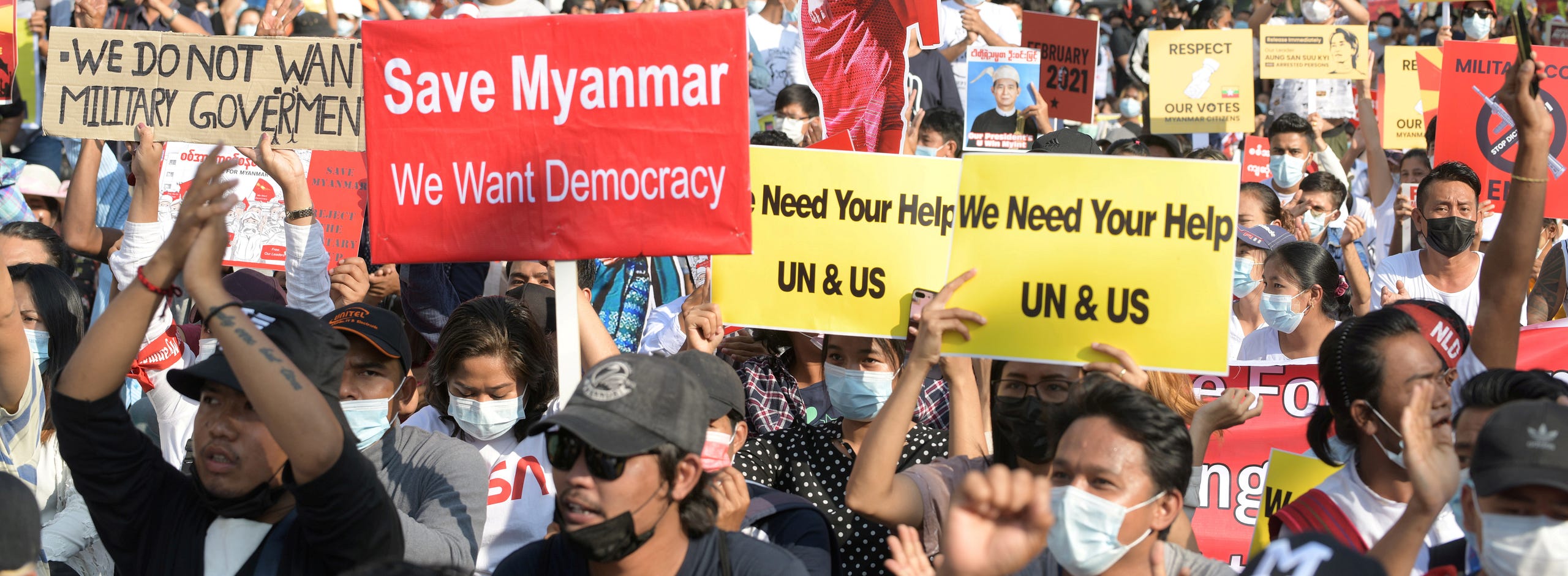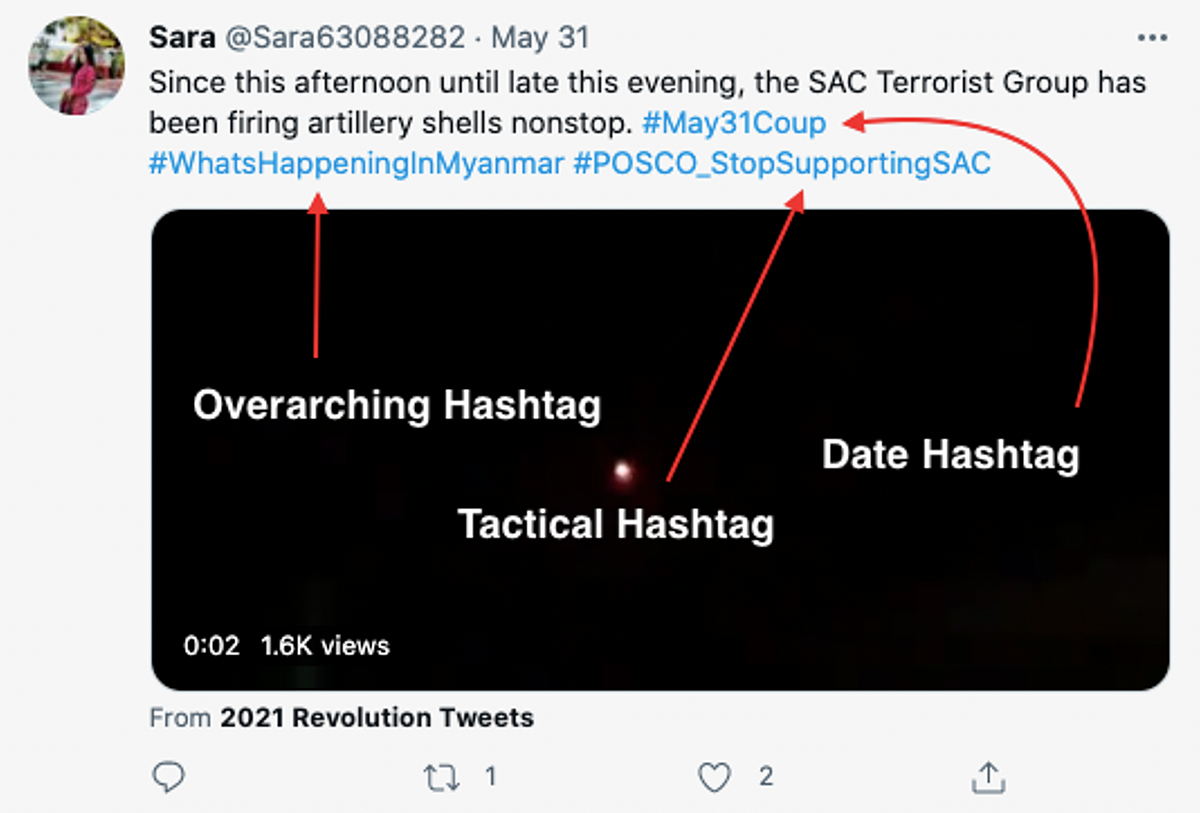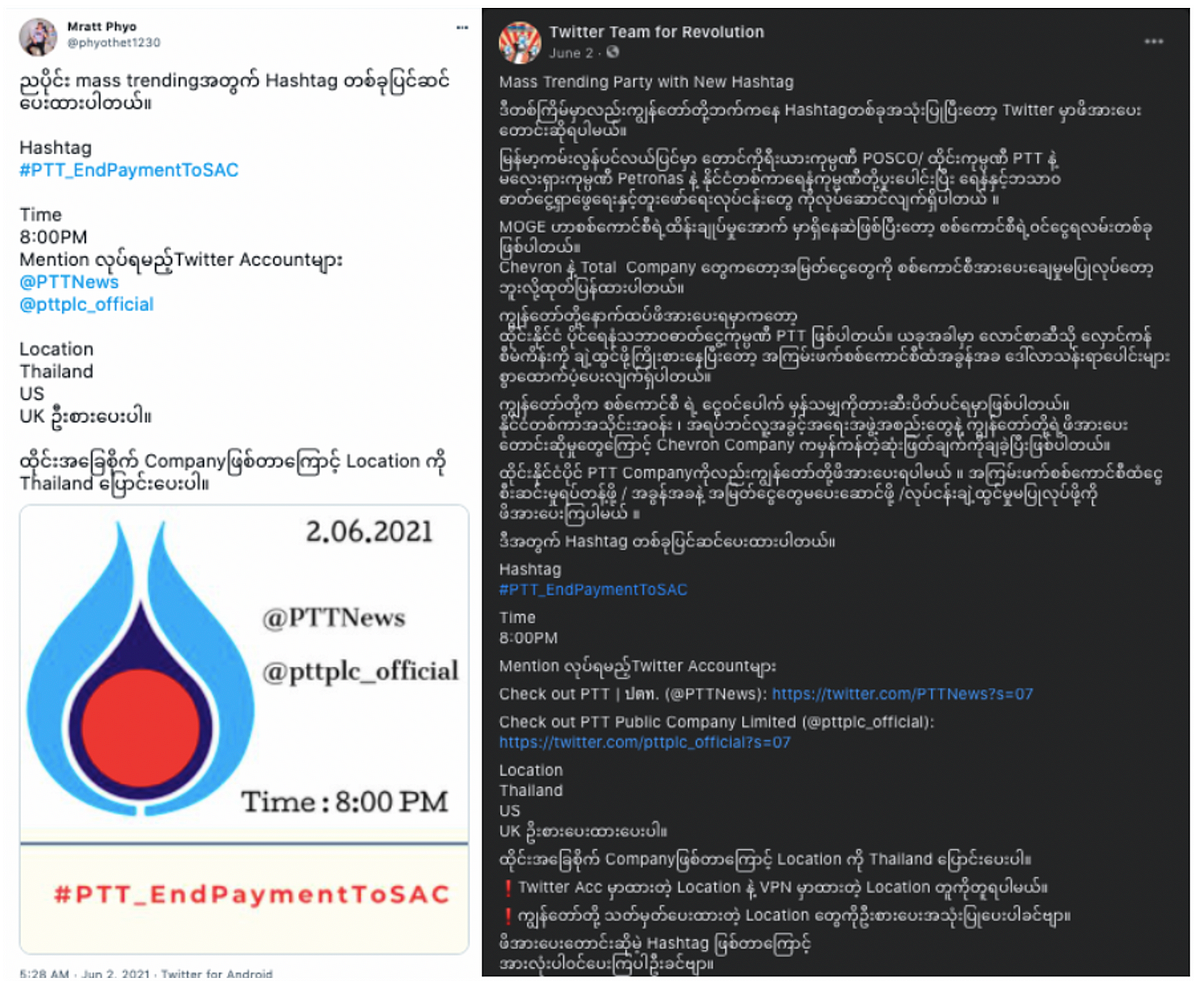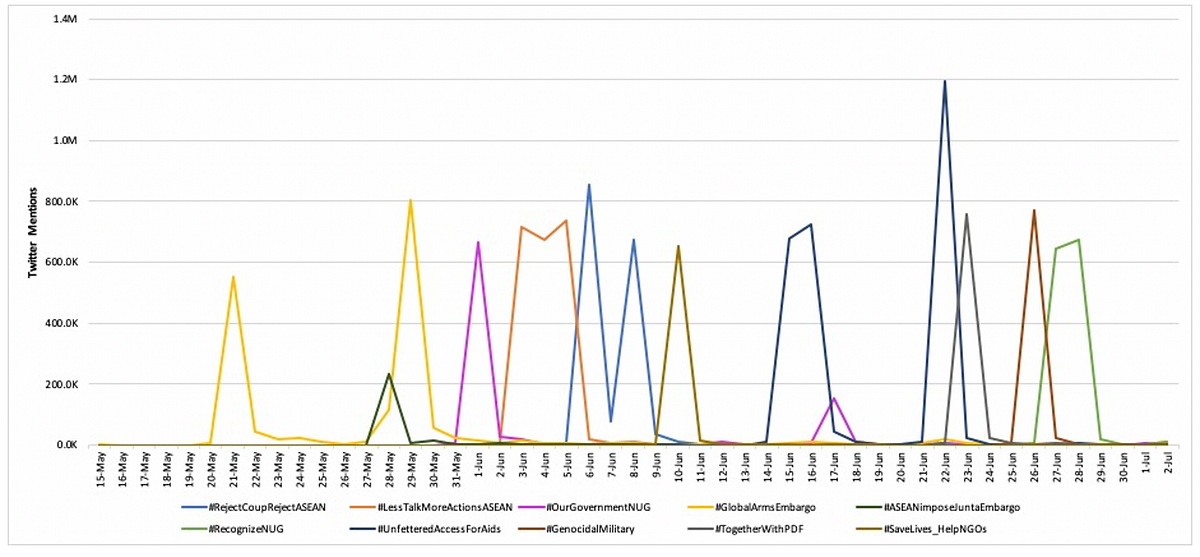Activists coordinate hashtags in a sophisticated fashion to amplify demands and document crimes by the military junta

By Avani Yadav
On February 1, 2021, a military coup d’etat in Myanmar led by Min Aung Hlaing ousted democratically elected leader Aung San Suu Kyi of the National League of Democracy. In the months since then, mass pro-democracy protests have torn through the streets and online, led mostly by young people. Activists have faced a heavy backlash from the junta, with authorities raiding journalists’ offices, shutting down every independent media outlet in the country, and ordering telecommunication companies to install intercept spyware to track dissident activity online.
Myanmar’s internet has been described as a “virtual battlefield,” with regular internet shutdowns and restricted access to social media. To keep their movement alive, pro-democracy activists have employed centralized coordination tactics on Twitter since late March, bringing together thousands of users in organized hashtag campaigns. Their unique use of hashtags is geared towards an international audience, and has been enormously successful, gathering millions of impressions daily.
Anatomy of a protest tweet
Each coordinated tweet has three main components: a date hashtag (for example, #June3Coup), an overarching hashtag (#WhatsHappingInMyanmar, etc), and a tactical hashtag. Tactical hashtags are timely hashtags that include specific actors and the demands of pro-democracy activists. From private corporations to governmental bodies, these hashtags have become a concise way for activists to hold actors accountable and gain exposure for the more granular elements of their movement.

For example, from late May and through early June 2021, #POSCO_StopSupportingSAC served as a tactical hashtag, urging the South Korean steel company POSCO to sever its financial ties with Myanmar’s State Administration Council (SAC). Hashtags meant to cultivate international pressure include #LessTalkMoreActionASEAN and #ASEANimposeJuntaEmbargo, which trended from June 1 to June 4. These came on the heels of a letter that all other ASEAN member states wrote to the UN General Assembly regarding a draft resolution on Myanmar. The letter called for the removal of a line demanding an arms embargo, prompting activists to condemn it.
Tactical hashtags also target crimes committed by the junta and bring attention to the material needs of people on the ground. #DreadfulCovidAmoungMilitaryCoup (trended on June 29) and #MyanmarNeedsO2 (trended on July 11) highlighted the third wave of COVID-19 sweeping the country and the junta’s inability to curb it. #WeNeedR2PInMyanmar was amplified from late March to early April, calling upon the international community to invoke Responsibility to Protect (R2P) in the face of the military’s human rights violations.
Many tactical hashtags have also pushed for recognition of the exiled National Unity Government (NUG) as the legitimate government of Myanmar, alongside NUG’s military wing, the People’s Defense Force (PDF). The hashtags #TogetherWithPDF, #OurGovernmentNUG, and #RecognizeNUG rolled out on June 23, June 1, and June 28 in pursuance of this goal.
A list of tactical hashtags reads like a treatise: it is clear, detailed, and most importantly, actionable. Tactical hashtags act as accessible, bite-size chunks of the pro-democracy movement that fit perfectly into tweets geared towards an international audience.
The coordination behind tactical hashtags
There are central pages and accounts on Twitter, Facebook and Telegram coordinating the daily use of tactical hashtags on Twitter. These accounts also organize massive “trending parties,” which last a few hours and have the goal of helping a tactical hashtag trend. New tactical hashtags are introduced every few days and they are often recycled over time.
Journalists Nu Nu Lusan and Emily Fishbein of Rest of World published an in-depth dive into the stories behind the founders of Twitter Team for Revolution on Facebook and Telegram, a major coordinating force behind hashtag use on Twitter. The admins behind these pages range from K-Pop stans to keyboard warriors, harnessing their collective online presence to bring awareness to Myanmar. Similarly, on Twitter, there are multiple central accounts coordinating hashtag use. These accounts regularly change their handles and operate multiple back-up accounts, dodging censorship while maintaining their online presence. Some are also a part of the Twitter Team for Revolution Facebook page. Most of these organizers are young people that grew up on the internet — they have an intricate understanding of social media, granting them a home field advantage online. The expertise they harbor is evident in the intentionality behind every trending hashtag.
Before a tactical hashtag is meant to trend, these coordinators send out the hashtag itself, an explanation behind it, safety instructions on using VPNs, and tips on navigating tweeting in English. The pinned tweet on one of the central coordinating accounts is about correcting a common typo in #WhatsHappeningInMyanmar, reflecting the detail with which this coordination is taking place.

The daily graphics used to disseminate hashtag information across platforms are identical, concise, and engaging. They are likely meant to help the message spread quickly, particularly over end-to-end encrypted offline messaging platforms such as Bridgefly, which Reuters reported was downloaded over one million times in Myanmar after the coup.

The movement’s use of VPNs is a tactic in itself. Given that VPN help protect a user’s privacy by routing their Internet activity through servers in different countries, the movement urges users to select the specific countries they want to raise awareness in. For example, the tactical hashtag for July 12 was #Telenor_M1IsPartnerOfSAC, targeting Telenor Myanmar, a former subsidiary of the Norwegian telecommunications company Telenor. In early July, the Telenor group sold Telenor Myanmar to M1 Group, an investment holdings group based in Lebanon that has business partnerships with Myanmar’s military government and is known to have investments in both Syria and Iran. Subsequently, the coordination posts for July 12 called for users to select VPN servers in Norway and setting their Twitter locations there to call attention to the Norwegian government. Similarly, hashtags targeted at the Petroleum Authority of Thailand in May called for users to use VPN locations in Thailand, and hashtags targeted towards the South Korean steel company POSCO placed their location in South Korea. Other popular VPN locations include Singapore, Germany, the United States and the United Kingdom.
The success and efficacy of pro-democracy activists online
These hashtags have been remarkably effective at constructing a chronological archive of the pro-democracy movement and maintaining exposure online. Firstly, both date and tactical hashtags are almost always only used on the days dictated by central coordinating accounts. Each tactical hashtag peaks for a day or two, precisely when it’s meant to, hitting up to 1.25M mentions and up to 250 million impressions a day. Hashtags from earlier in the year were less successful, but still often accumulated 5K to 100K mentions. Date and overarching hashtags have often surpassed 300 million daily impressions.


While some tactical hashtags are introduced by the coordinators, others — particularly ones from March and April — grew organically and were absorbed into coordinated efforts in May and June. One example of this is #RecognizeNUG, which first appeared in early April, reaching 368,166 impressions with 1,766 mentions on April 19. But it did not take off until June 28, when coordinating accounts began included it as a tactical hashtag. That day, the hashtag received over 140 million impressions.

All three types of hashtags also regularly trend. The Twitter Team for Revolution Facebook page, the coordinating force behind many hashtags, keeps a detailed account of when and where their efforts are successful. According to one post, for example, hashtags such as #June22Coup and #UnfetteredAccessForAids trended in the United States, Singapore, Germany, Hong Kong, Thailand, and Myanmar itself.
The organization of this digital campaign has constructed an accessible archive of the coup and the efforts against it. Coordinated tweets are often accompanied by eyewitness media documenting everything from mass protests to human rights violations committed by the military government. For a comprehensive overview, a user can check an overarching hashtag. For a day-to-day breakdown, they can check date hashtags. Tactical hashtags are scattered throughout, highlighting the needs and demands of the movement at the time.
To date, the overarching hashtag #WhatsHappeningInMyanmar has been mentioned 216 million times, with 48.1 billion impressions. The architects of this success embody a deep understanding of social media, one that has ensured the voice of democracy in Myanmar will not go unheard.
Avani Yadav is a research intern with the Digital Forensic Research Lab.
Cite this case study:
Avani Yadav, “How pro-democracy activists in Myanmar keep their movement alive with hashtags,” Digital Forensic Research Lab (DFRLab), August 6, 2021, https://medium.com/dfrlab/how-pro-democracy-activists-in-myanmar-keep-their-movement-alive-with-hashtags-34ff2d3eddf2.
Follow along for more in-depth analysis from our #DigitalSherlocks.

